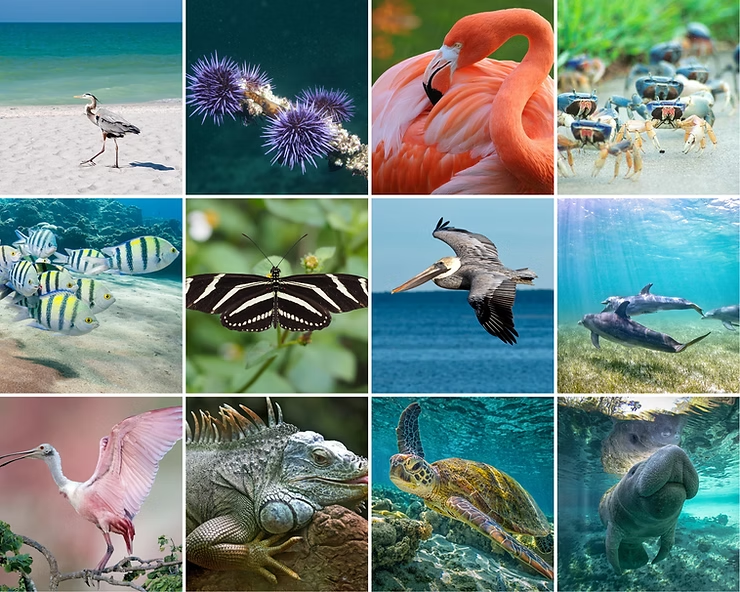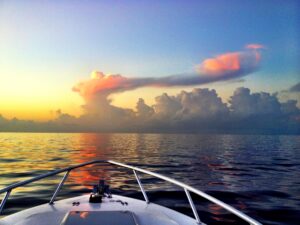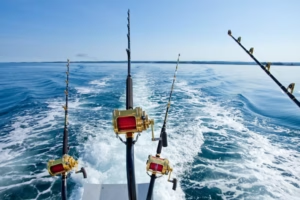In this season of rising temps, dive into Florida’s coastal scenes and meet the locals! Manatees cruising lazily and dolphins putting on a show, catch the sea turtles making their nests, migratory birds soaring in formation, and the underwater world alive with colorful fish. With Gulfstream Boat Club you get a front row seat to the most amazing sights – Let’s we navigate through the springtime Florida wildlife all along the coast!
What Makes Springtime Special on the Water?
- Mating and Nesting Season
- Migratory Patterns
- Warmer Temperatures
- Clearer Waters
- Abundance of Food
- Wildflowers and Blooming Vegetation
- Comfortable Weather
Some Florida Wildlife Locals You Can Expect to See!

Great Blue Heron
Whether poised at a river bend or cruising the coastline with slow, deep wingbeats, the Great Blue Heron is a majestic sight. This stately heron with its subtle blue-gray plumage often stands motionless as it scans for prey or wades belly deep with long, deliberate steps. They may move slowly, but this Florida Wildlife local can strike like lightning to grab a fish or snap up a gopher. In flight, look for this widespread heron’s tucked-in neck and long legs trailing out behind.
Sea Urchin
Sea urchins have a round shaped body with long spines that come off it which are used for: protection, to move about, and to trap food particles that are floating around in the water. The feet of the sea urchin have suckers which help the sea urchin to move about, capture food, and to hold onto the ocean floor. Sea urchins do not have a brain and instead rely on their water-vascular system– a circulatory system that comprises of water-filled channels which run through the body of the sea urchin.
Pink Flamingo
With their pink and crimson plumage, long legs and necks, and strongly hooked bills, flamingos cannot be mistaken for any other type of bird. he flamingo’s pink or reddish color comes from the rich sources of carotenoid pigments (like the pigments of carrots) in the algae and small crustaceans the birds eat. Flamingos are social birds that live in groups of varying sizes, from a few pairs to sometimes thousands or tens of thousands.
Fiddler Crabs
Ever chance upon a troop of fiddler crabs marching through the mud in a salt marsh or mangrove forest? The male fiddlers were probably the most obvious – they have one oversized claw that resembles a fiddle. The claw is waved around to attract females during courtship and is used as a defense against other males. Fiddler crabs dig burrows about a foot deep in the sand close to the water’s edge. They retreat to these holes when alarmed or when the tide comes in. The opening is plugged with sand or mud to keep out the water.
Sergeant Major Fish
This small, flat, oval shaped reef fish has five distinct black bars on its sides. While in sandy areas and over reefs, it is in its light phase, generally silvery gray with a yellow sheen along its upper sides; and when hiding in a cave or crevice, it enters its dark phase, with its body going darker gray blue, almost blending in with its dark bars. Named from the military stripes they resemble, the sergeant majors school in groups of hundreds for feeding, but during spawning season, the male will aggressively guard his nest.
Zebra Longwing Butterfly – Official FL State Butterfly
Zebra longwings are found throughout the state, but this common Florida butterfly is anything but ordinary! Zebra Longwings live an unusually long life, and can survive more than a month as adults rather than the typical 1–2 weeks as most butterflies. This is partly because they ingest pollen as well as nectar, giving the Longwings an extra source of protein.
Florida Brown Pelican
Brown Pelicans are huge, stocky seabirds. They have thin necks and very long bills with a stretchy throat pouch used for capturing fish. Their wings are very long and broad and are often noticeably bowed when the birds are gliding. They feed by plunge-diving from high up, using the force of impact to stun small fish before scooping them up. They are fairly common today—an excellent example of a species’ recovery from pesticide pollution that once placed them at the brink of extinction.
Bottlenose Dolphin
There’s no list of Florida wildlife complete without the mention of everyone’s favorite local! Thought to be some of the smartest animals on Earth, bottlenose dolphins send messages to one another in many different ways. Bottlenose dolphins squeak, squawk and use body language—leaping as high as 20 feet in the air, snapping their jaws, slapping their tails on the surface of the water, blowing bubbles and even butting heads. Each dolphin has a special whistle that it creates soon after it is born. This whistle is used for identification, just like a human’s name.
Roseate Spoonbill
The flamboyant Roseate Spoonbill looks like it came straight out of a Dr. Seuss book with its bright pink feathers, red eye staring out from a partly bald head, and giant spoon-shaped bill. Groups sweep their spoonbills through shallow fresh or salt waters snapping up crustaceans and fish. They fly with necks outstretched, to and from foraging and nesting areas along the coastal southeastern U.S., and south to South America. These social birds nest and roost in trees and shrubs with other large wading birds.
Green Iguana
Green iguanas are not native to Florida and are considered an invasive species due to their impacts to native wildlife. Green iguanas are large, typically green lizards, though they can sometimes be brown or almost black in color. Some adults can take on an orange or pink coloration during certain times of the year. Hatchling and young green iguanas usually have bright green coloration.Male green iguanas can grow to over five feet in length and weigh up to 17 pounds!
Green Sea Turtle
Green sea turtles spend most of their lives underwater, where they can rest for up to five hours at a time before coming up for air. When active, they typically alternate between being underwater for a few minutes and coming up to the surface to breathe air for a few seconds. Green sea turtles are also known to sunbathe on land. Unlike most other sea turtles, adult green sea turtles eat a primarily plant-based diet consisting of seaweed and sea grass. Scientists believe these green foods give the sea turtle’s fat its green color. The shell of the green sea turtle is usually shades of a brown or olive color.
West Indian Manatee
No one in Florida really needs an introduction to the Florida Manatee. They are native to the state and are an iconic mammal for Florida. Manatees are a federally protected endangered species and have been on the endangered species list since 1973. Back in 1991, there were estimated to be only a little over 1,200 manatees in the state of Florida. Today, there are estimated to be over 6,300 individuals. The main threat to manatees used to be collisions with boats and habitat loss, but manatee protection zones that reduce speed and/or restricted operation of water vessels, as well as restrictions on waterfront development, played a huge part in helping the species rebound.


